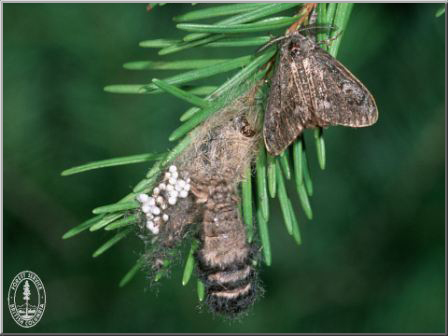
The insect known as Douglas-Fir Tussock moth began showing up again around the Denver Metro Area in 2015; it pops up in sporadic pockets in landscapes and parks. The larva of this insect feeds on needles of Spruce, Douglas-Fir, White Fir and Concolor Fir. The feeding of this larva typically begins at the top of the tree and moves downward. Feeding can become extensive and complete defoliation may occur.
 Douglas-Fir Tussock moth larva hatch in the spring and move toward the soft, newly emerging tissue to begin feeding. Feeding by the larva will occur from May to late July, when pupal cocoons form. The adults emerge in late July-August, and begin to mate and lay eggs. The egg masses will overwinter and hatch in the spring.
Douglas-Fir Tussock moth larva hatch in the spring and move toward the soft, newly emerging tissue to begin feeding. Feeding by the larva will occur from May to late July, when pupal cocoons form. The adults emerge in late July-August, and begin to mate and lay eggs. The egg masses will overwinter and hatch in the spring.
There are several natural predators of Tussock moth which help to keep populations from becoming too heavy. This insect population can grow enough to impact small groups of trees in a localized population. Insecticide applications can provide good control where populations have reached damaging levels.
It is important to look for, and positively identify, this pest so proper treatments can be applied where needed. Locating egg masses in the winter is a good sign that a population of Douglas-Fir Tussock moth has taken up residence in an area. a.
